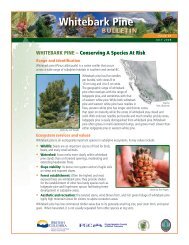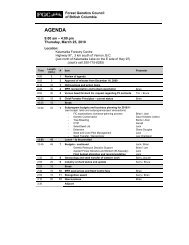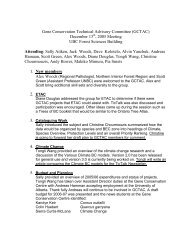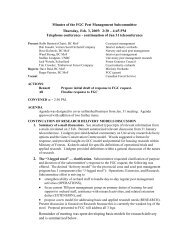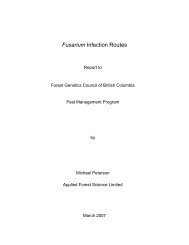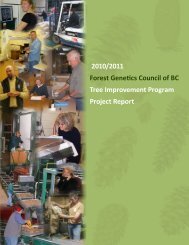Tree Improvement Program Project Report 2006 / 2007
Tree Improvement Program Project Report 2006 / 2007
Tree Improvement Program Project Report 2006 / 2007
You also want an ePaper? Increase the reach of your titles
YUMPU automatically turns print PDFs into web optimized ePapers that Google loves.
.10 Inter or Spruce <strong>Tree</strong><br />
Breed ng <strong>Program</strong><br />
Barry Jaqu sh, Val Ashley, G sele Ph ll ps and<br />
Bonn e Hooge<br />
The Interior spruce tree-breeding program in British<br />
Columbia is structured in two phases. Phase I began in<br />
the mid-1960s and focussed on three geographic regions:<br />
Prince George, Bulkley Valley, and the East Kootenay.<br />
Phase II began in the mid-1970s and focussed on other<br />
geographic regions where Interior spruce is commercially<br />
and ecologically important. The program has progressed to<br />
the point where much of the current planting stock (more<br />
than 80 million seedlings per year) comes from rogued firstgeneration<br />
seed orchards, and full-sib second-generation<br />
progeny tests are in place for three seed planning units. In<br />
<strong>2006</strong>, 65 trees in the 10-year-old Series I Prince George<br />
Selection Unit second-generation progeny tests (Figure<br />
13) were selected, grafted, and established in holding beds<br />
where they will be held for one to two years and then<br />
moved into seed orchards.<br />
In the mid-1990s Interior seed planning zone review,<br />
the Prince George Interior spruce SPU was realigned to<br />
include six small seed planning units from the Phase II<br />
program and the Prince George Selection Unit from the<br />
Phase I program. This realignment resulted in a composite<br />
breeding population of 1,140 tested parent trees for the<br />
T R E E I M P R O V E M E N T P R O G R A M<br />
P R O J E C T R E P O R T 2 0 0 6 / 2 0 0 7<br />
new Prince George SPU. The second-generation crossing<br />
plan for this new zone consisted of crossing the top 144<br />
parents in a six-tree incomplete partial diallel crossing plan<br />
where each parent was crossed with four other parents. This<br />
plan resulted in 24 partial diallel units and a maximum of<br />
288 crosses. Crossing was completed over four breeding<br />
seasons, and four progeny tests were planted in spring<br />
<strong>2006</strong>. These tests were established in an incomplete block<br />
Alpha design with ten replications per site, 13 blocks per<br />
replication, and 20 seedlots per block. Experimental units<br />
consisted of three-tree row plots with trees planted at 2 x 2<br />
m spacing (Figure 14).<br />
In spring <strong>2006</strong>, four realized gain tests were established<br />
in the Prince George SPU. These tests will compare the<br />
growth performance on an area basis of elite families, seed<br />
orchard seedlots, and a wild-stand seedlot comprised of a<br />
composite of ten wild-stand seedlots.<br />
Site maintenance and measurements were conducted<br />
on various research sites, including the 10-year-old East<br />
Kootenay second-generation progeny tests, the spruce<br />
seed orchard after-effects field tests near Prince George,<br />
12 spruce climate change study sites, and the Chilliwack<br />
Picetum.<br />
Controlled crossing to produce full-sib families for<br />
second-generation selection is ongoing in the Nelson<br />
and Thompson Okanagan SPUs (breeding for TO SPU<br />
conducted by Tolko Industries at the Eagle Rock seed<br />
orchard).<br />
F gure 13. Ten-year-old Ser es I<br />
Inter or spruce second-generat on<br />
progeny test near Pr nce George, BC.<br />
1



